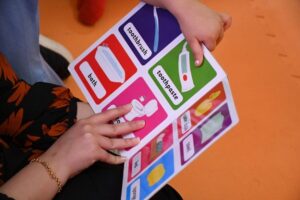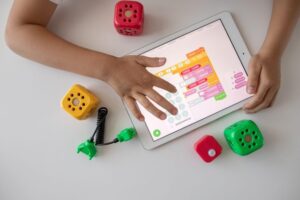Common misconceptions about non-speaking autistic children and communication options
Communication is a fundamental human need that everyone deserves access to, regardless of their abilities. However, for non-speaking autistic children, it can be challenging to communicate in the traditional sense. There are several common misconceptions about non-speaking autistic people that are important to address before exploring communication options.
Firstly, non-speaking autistic people can understand the world around them, and it is essential to always assume competence. Just because someone is not talking does not mean they do not understand you. Secondly, if a child is non-speaking, it does not mean they will remain so all their life. While there is a chance they may never speak, there is also a chance they will start to speak when they are ready and with the right support/environment. It is essential to remember that no doctor or speech therapist can determine this.
Lastly, it is important to use the right language when discussing non-speaking versus non-verbal. Some people from the autistic adult community have expressed discomfort with the word “non-verbal” and prefer non-speaking. It is crucial to be aware of the language used when addressing people because the term non-verbal means without words, which is not exactly the case for non-speaking autistic children/adults. They still understand words, use them possibly in writing, and may verbally express some words, depending on where they are in their language journey. It is also important to note that non-speaking is not a determinant of intelligence.
Different communication development
Due to the different wiring in their brains, non-speaking autistic children may have different types of communication styles. It is essential to find a way that works for them to help them express their thoughts and needs until they are ready to communicate verbally.
Here are some communication options that may be helpful for non-speaking autistic children:
Picture Exchange Communication System (PECS)
PECS is a popular communication option that uses pictures or symbols to represent words and phrases. It encourages children to communicate by pointing to the appropriate picture or symbol. PECS can be used to communicate basic needs such as food, drink, and toilet, as well as more complex thoughts and ideas.

Below are some helpful tips on how to create a PECS file at home or in the school environment:
- Gather materials: You will need a set of picture cards or symbols, a binder or folder to keep the cards in, and a communication board or book to display the cards.
- Choose appropriate pictures: You will need to select clear, simple, and meaningful pictures to represent the items or actions that the person wants to communicate. You can create your own pictures or use commercially available sets of PECS symbols.
- Organize the pictures: Arrange the pictures in categories, such as food, drinks, activities, etc. You can also organize the pictures in a sequence to help the person communicate more complex requests.
- Teach the exchange: Start by teaching the person to give the communication book or board to someone else and exchange it for the desired item or action. You can also teach the person to point to or select the desired picture from the communication board.
- Complete the exchange: By providing the desired item or action when the exchange is made. This will encourage the person to continue using the system.
- Expand the system: As the person becomes more comfortable with the PECS, you can add more pictures and categories to expand the system. You can also teach the person to use more complex requests, such as combining pictures to make a sentence.
It’s important to be patient and consistent as you implement PECS and to work closely with a speech therapist or professional if possible. By using PECS, you can help adults and children communicate their wants and needs, improving their quality of life.
Augmentative and Alternative Communication (AAC) Devices
AAC devices range from simple communication boards with pictures or symbols to more advanced devices such as speech-generating tablets. These devices allow children or adults to communicate by pressing buttons or icons on the device, which then produce speech or other sounds.

Examples of AAC devices include:
- Speech Generating Devices (SGDs): These are electronic devices that produce speech when the user presses a button, touch screen, or switch. SGDs can also have pre-programmed messages and allow for the creation of custom messages.
- Dynavox Devices: Dynavox is a brand of speech-generating devices that offer a range of options for individuals with different communication needs, from simple communication boards to more advanced speech-generating devices with advanced features such as eye-gaze and touch-screen technology.
- ProxTalker: ProxTalker is an AAC device worn on the wrist and programmed with various messages that can be spoken when buttons are pressed.
- Lightwriters: Lightwriters are small, portable devices that allow the user to type messages that are then displayed on an LED screen. The messages can be spoken out loud or displayed silently.
- AlphaSmarts: AlphaSmarts are small, portable word processors that allow the user to type messages and save them for later use. The messages can be displayed on the device’s screen or transferred to a computer.
These are just a few examples of the types of AAC devices that are available. The type of device that is best for an individual will depend on their specific communication needs and abilities.
Sign Language and Gestures
Sign Language is a great option for non-speaking autistic children. It is a visual language that uses hand gestures, facial expressions, and body language to communicate. Sign language can be taught to children and their families or caregivers, and it can also be used to communicate with others who know sign language. It also helps in developing cognitive, linguistic, and social-emotional skills. Sign language is different all over the world, and the one you use will depend on where you live.

Makaton is a symbol and sign language developed specifically for autistic people, when using this communication system, the person teaching uses a combination of words, symbols, and signs to enhance the communication exchange.
There are also various apps and software that can help non-speaking children and adults communicate. These include communication apps, social story apps, and visual schedule apps. These apps can help children learn new vocabulary and concepts, and can also be used to create personalized communication books and social stories.
It is important to remember that there is no one-size-fits-all solution when it comes to communication options for non-speaking autistic children.
It is essential to work with a speech therapist or other communication expert to find the best communication option for your child. With the right communication tools and support, non-speaking children can learn to express themselves and connect with the world around them.
Learn how to implement communication strategies at home for your autistic child with our online course – empowering you to foster growth and development!
Conclusion
The world of communication options for non-speaking autistic children is filled with a variety of tools and technologies designed to help individuals express themselves and connect with the world around them. Whether it’s through picture communication boards, speech-generating devices, or alternative forms of communication like sign language or gestures, there are many options available for non-speaking children and adults.
Parents and caregivers need to work closely with speech therapists and other professionals to determine the best communication options for their children. With the proper support and tools, non-speaking autistic children can develop the skills they need to communicate effectively and lead fulfilling lives.
In the end, it’s about finding the right fit for each child and providing them with the resources and support they need to succeed. The world of communication options for non-speaking autistic children is constantly evolving, and with new technologies and innovations being developed all the time, there’s no limit to what one can achieve.
